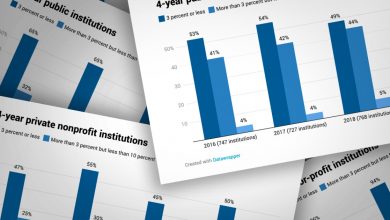Despite Renewed Commitment to Diversity, Colleges Make Little Progress, Report Says

Colleges in recent years have boasted that they are steadfastly committed to student and faculty racial diversity.
But a new analysis by McKinsey & Company says that’s really more talk than action.
Higher education, like the United States, has challenges when it comes to its history.
In fact, at the current rate, it would take colleges another 70 years to recruit enough Asian, Black, Latina/o, and Native American students for their enrollment to somewhat reflect America’s demographics. And that figure would be dominated by and Latina/o students.
For Native American and Black students, it would take more than 300 years to form a representative student body.
Colleges collect flawed and incomplete racial enrollment data, struggle to reflect on their own racist history, and fail to invest adequate time and resources into diversity, equity, and inclusion efforts, according to the report.
The McKinsey analysis, “Racial and Ethnic Equity in U.S. Higher Education,” shows that, since 2020, more than 130 research institutions have publicly shared plans or aspirations to diversify their student bodies and work forces, and to build equitable and inclusive communities where people of color have access to the same resources as white students and feel like they belong.
At least 95 percent of these colleges have a senior diversity equity and inclusion executive, according to the report. But there seems to be a disconnect between colleges’ stated efforts and reality, says Duwain Pinder, a leader of the McKinsey Institute for Black Economic Mobility and one of the report’s authors.
For some universities, the percentage of Latina/o enrollment overall has recently increased. But Black students, Native American students, and faculty from all underrepresented populations, saw effectively no progress from 2013 to 2020, the report says.
Just 8 percent of institutions have a student body that’s reflective of America’s racial diversity and a graduation rate for students of color that’s similar to white students,’ according to the report.
In 2020, 44 percent of all two- and four-year colleges met the expectations of student representational parity, based on the racial and ethnic demographics of students’ home states.
The authors created an “expected racial/ethnic composition if enrolled at parity” for each institution’s first-year undergraduate class, based on the demographic makeup of the traditional college-going population within states that it enrolls students. They then compared it with the actual racial and ethnic composition of each institution’s first-year undergraduate class. The difference is each institution’s gap in parity.
The reasons inequities persist across all underrepresented groups are interrelated and complex, the report says.
Poor-quality K-12 education, selective admissions practices, and a lack of faculty diversity are just a few barriers standing between underrepresented groups and their enrollment in higher education.
Some of these barriers, like tuition affordability and housing, are “low-hanging fruit,” says Debra Humphreys, vice president for strategic engagement at the Lumina Foundation. But the less obvious deterrents, like campus-climate issues, can be found only when institutions go into classrooms and conduct their own campuswide research.
The report lists a few steps that institutions can take to attract and retain more students of color.
Colleges should reflect on their own racist history and their campus culture, evaluate their student-recruitment strategies, and invest more in diversity efforts, such as expanding dual-enrollment programs, forgiving student debts, and partnering with minority-serving institutions.
Of these steps, Pinder says that there are two areas most institutions get stuck on the most. One is “reflection.”
“Higher education, like the United States, has challenges when it comes to its history,” he says.
For decades, many institutions excluded nonwhite students from enrolling while profiting from Native American genocide and the enslavement of Black people, for example.
Institutions need to reckon with that history before they can move forward, he said.
Colleges should also set more specific equity goals and hold themselves accountable, he said.
The report cites the Johns Hopkins University’s decision to eliminate its legacy admissions to create more seats for people of color and the University of Massachusetts’ decision to reserve 20 percent of its hiring budget for recruiting and retaining faculty members from historically marginalized groups.
Pinder says that racial diversity and equity should be top of mind for the entire institution, including how scholarships are distributed, how faculty design their curriculum and teach, and how the college interacts with its surrounding community.
“Racial and ethnic equity is not just an admissions thing, it’s not just a thing to do when you’re trying to increase the diversity of your student population. It should be a strategic imperative across your entire university,” he says.
Source link






